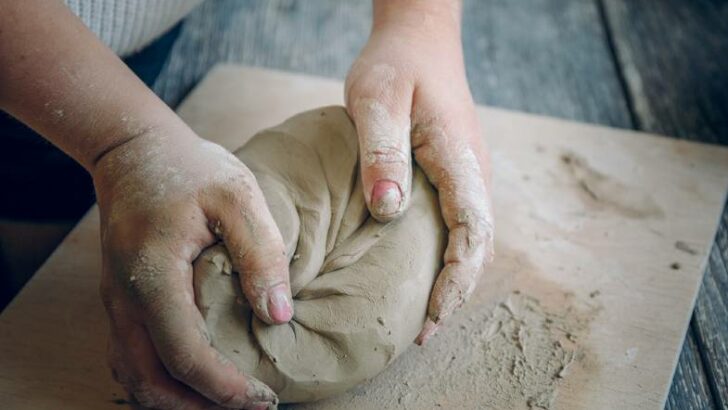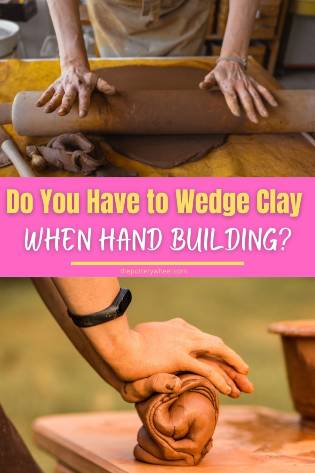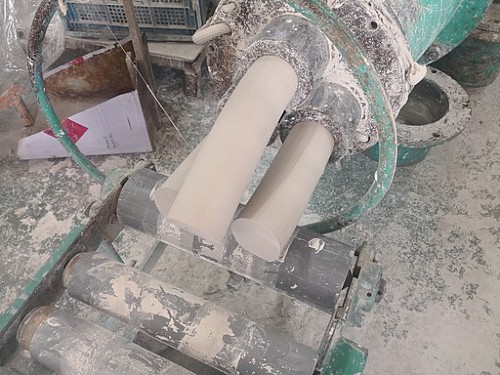Your cart is currently empty!
Do You Have to Wedge Clay When You Are Hand Building?
Published:
Last Updated:

Affiliate Disclaimer
As an affiliate, we may earn a commission from qualifying purchases. We get commissions for purchases made through links on this website from Amazon and other third parties.
Wedging clay is a very good idea if you are making pottery on a potter’s wheel. But is it do you have to wedge clay when you are hand building your pottery? I love hand building pottery and I don’t love wedging! So, it was one of the questions I wondered about when I began making things out of clay. This is what I have learned…
If the clay that you’re using is newly purchased, and moist, then wedging clay when you are hand building is not essential. However, if the clay has an inconsistent texture or moisture level or contains air pockets, it’s best to wedge it. If the clay isn’t wedged it can be hard to handbuild even smooth forms.

To Wedge or Not to Wedge Clay When You Are Hand Building?
There are several reasons for wedging clay. Let’s take a quick look at each of these reasons and consider if they apply when hand building…
Consistency
The first reason is that it evens out the consistency of the clay. Sometimes clay has sections that are harder and drier than others. When you wedge you get rid of the patches of dry and wet clay. After wedging the clay should be smoother and less lumpy or chunky.
Throwing clay on a wheel that has an uneven consistency is tricky. This is because parts of the clay will thin out more quickly than others. So, you can end up with a piece that walls with an uneven thickness.
Hand Building with Uneven Clay
The same is true for hand building. Whatever hand building technique you use, it will be harder to make an even shaped form if the clay has an uneven consistency. For example, if you try to roll a coil of clay, some sections of the coil will likely be thicker than others.
It’s hard to roll an even-shaped coil if your clay is lumpy. The same is true if you are pinching your pottery. As you pinch, your hands will find it easier to thin out some sections of clay than others. This will likely result in a pinch pot with uneven walls.
If you are slab building and rolling out your clay with a rolling pin, lumpy clay can be an issue. It’s hard to roll an even slab of clay if part of the clay is soft and the other part is hard.
Of course, you might use a slab roller, which would make a slab with an even thickness. Or you might use wooden strips on either side of the rolling pin to keep the slab even.
This will help you get a slab that looks even. However, if some parts of the clay are denser than others, then your piece might dry unevenly. When clay dries unevenly, it can put the pottery under stress and cracks can form.
Getting Rid of Air Bubbles
Another important reason for wedging is to get rid of air bubbles in the clay.
It’s often said that air bubbles in your clay are what cause pottery to explode in the kiln. This isn’t strictly speaking true.
It isn’t the air bubbles themselves that cause the explosion. Rather, when the pottery is fired, moisture in the clay turns into steam and expands into any air pockets in the clay. This puts pressure on the pottery and causes the clay to shatter.
So, technically air bubbles in the clay don’t cause a problem with firing, provided the clay is bone dry before it’s fired.
However, air bubbles in clay do make it harder to work with. This is true whether you are making your pottery on the wheel or hand building.
When you’re wheel throwing, an air bubble in the clay can make the clay go wonky and off-center.
But equally, when you are hand building, a bubble in the clay can make the surface uneven. When you are pinching, coiling, or slabbing clay, if you burst a stray bubble, you can end up with a dent or dip in the clay. This creates a small area in the clay that is thinner than the rest. Which can be enough to blight an otherwise nice even surface on your piece.
So, there are some good reasons to wedge clay when you are hand building pottery.
Nevertheless, whether wedging is necessary does depend on the clay you are using. So, let’s take a look at that now…
What Clay Are You Using?
Although there are good reasons to wedge clay when you are hand building, it’s not always necessary.
When you have bought a bag of clay from a pottery supplier, it will be supplied in a sealed plastic bag. This clay has been produced by a manufacturer. The raw materials are mined, blended, ground, refined, and then extruded through a big pug mill.
When clay comes out of the industrial pug mill it has been de-aired. It has also been treated so that it has an even moisture content and density. If you’d like to know more about the best clay for hand building, you can check out this article that I wrote on exactly that topic.

Encik Tekateki, CC BY-SA 4.0, via Wikimedia Commons
As such, new clay can be sliced off from the packet and used without being wedged. If I have a new batch of clay, I generally don’t wedge it.
However, if the clay has been sitting around in my clay cupboard for months it may have dried out a bit. If clay sits unused in its clay bag, moisture does evaporate, even through the plastic. The outside of the clay is likely to be drier and harder than the inside layer.
As such, it can help to wedge clay when you are hand building. Wedging will even out the moisture levels in clay that’s been left to sit unused.
Recycled Clay?
If you are reusing clay or recycling it from scraps, it’s essential to wedge clay when you are hand building. Clay that is being reused or recycled will have a mixture of different levels of moisture. Some will be very dry and other bits will likely be very wet like slurry. It’s important when reusing or recycling clay to wedge it really well before throwing or hand building with the clay.
Although it isn’t fun, wedging is the only way you will get your recycled clay into a fit state to be used again. Some potters have a pug mill in their studio. This is handy if you are producing a lot of pottery. However, most of the potters I know who have a pug mill say that it’s more hassle to clean the pug mill after it’s been used than it is to wedge the clay.
Final Thoughts
So, the conclusion is that unless you are using pristine new clay straight from the bag, it’s best to wedge clay when you are hand building. Wedging may not be the most fun way to spend your time in the studio. However, it does help prevent the disappointment of a pot with uneven or pitted surfaces. Or cracked clay as it dries.



